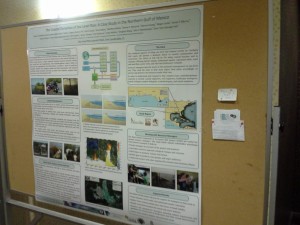So, this is a bit of a review considering that I’ve been home for a few days (though busy, busy the whole time), but I wanted to at least put down some of the highlights of the conference while I have time…and before leaving for Ithaca.
On the first day of the conference, I attended two panels on psychology and ESS (environmental studies & science). These were interesting because several speakers tackled some fairly big issues, like how to make people aware of massive environmental problems without causing them to succumb to despair, and what effects positive emotion in communication have on the audience vs. negative emotions. This is definitely not an area of expertise for me, and I can see how looking further into research on the subject will be useful.
Later, I went to a session bringing together some different perspectives on climate change (which turned into the theme of the day for me, quite unintentionally). Here, several of the presentations had a focus on framing, which made up a large part of my own presentation. The one I found most interesting was by Thomas Eatmon (Allegheny College), who spoke about parallels in risk assessment frameworks between geoengineering and nanotechnology. This was interesting for a few reasons- first, risk is a complex thing to conceptualize in any situation, and it gets much more so when new technology, large-scale technical research, politics, etc. are part of the picture. Second, as Eatmon points out, the environmental community has to a large extent avoided discussing geoengineering, and instead sees it as “taboo”. But as he pointed out, this leaves the subject of framing the geoengineering debate open to industry/corporations- exactly where we are right now. He suggests, instead of framing geoengineering as “climate engineering”, that we view it as nanotechnology (e.g., ocean iron fertilization, aerosolized sulfur)- a much more threatening frame in the public eye, and one which I think does capture the scale of this type of proposal. Other projects, like space mirrors or CO2-capturing gels, are more point-source (or sink, if you prefer) and more easy to discontinue if problems come up. The “nanotech” parallel seems to be a good thing to bring up for the former category of proposals.
The last session I went to was a grab-bag of sorts for the student presentation competition. There were some interesting conceptualizations brought up in this session of environmentalism and social liberalism (definitely not always connected) and ideas about wilderness environmentalism vs. “environmentalism of the poor” (tied to making a livelihood from the land and social justice). Throughout this conference, I was reminded that “environmental studies” is often a very separate realm from ecology, which is where my background is. I’m sure some of the things I was picking up on were pretty basic to environmental studies folks, but hopefully this makes what I have to contribute potentially new & useful as well.
